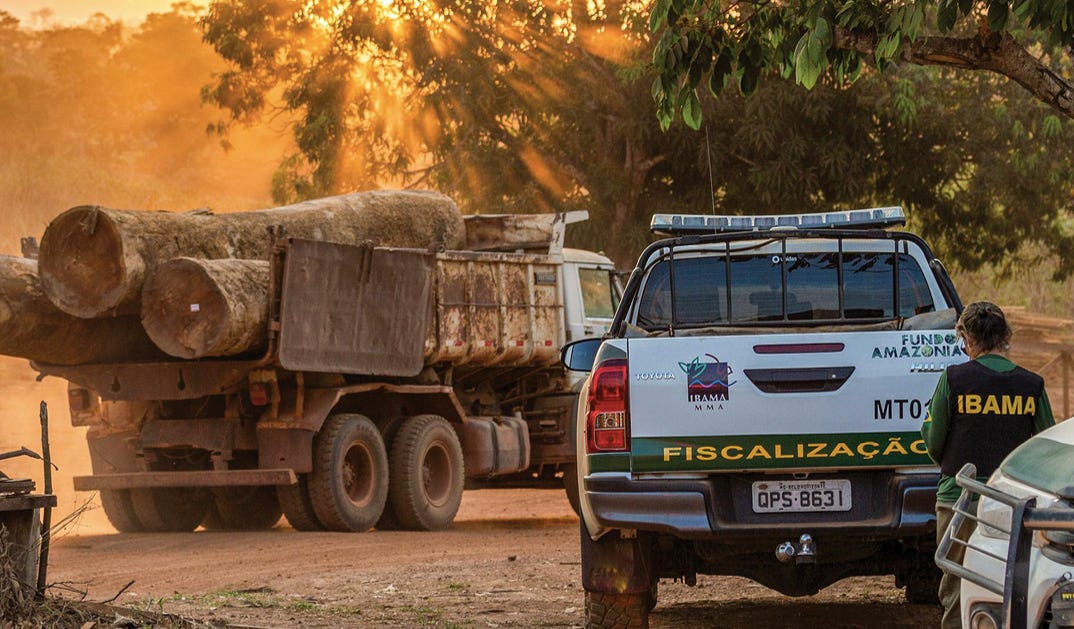How US and EU firms are complicit in the ‘legal-but-illegal’ logging of the Amazon
New report by Environmental Investigation Agency exposes timber laundering in Brazil
I’ll never forget hearing someone from the Peruvian state’s forests watchdog agency tell me how he once travelled for however many days into an indescribably remote part of the Amazon in order to verify a GPS-tagged logging operation, and how it began to dawn on him, as the days went by, that he just wasn’t going to find anything. That’s to say, that there was no logging operation, and that no one had ever gone up there, at least in recent years, to extract any serious, industrial-scale quantity of trees. And that if he went any further upriver all he would find, despite the official documents providing GPS coordinates for the general harvest area as well as the exact trees supposedly felled, was largely undisturbed primary forest.
For some years in Peru, this sort of experience was all-too-common: forests watchdog inspectors, from the Organismo de Supervisión de los Recursos Forestales y de Fauna Silvestre (OSINFOR), would turn up to verify a logging operation in some part of the Amazon and find no evidence of any kind of timber extraction whatsoever. The reason this was so common was simple: it was a consequence of the way that loggers, sawmills, logging companies and international traders etc were making illegally-logged timber appear legal. The basic strategy: to pretend the wood comes from, say, Point A by using the paperwork pertaining to that location in order to move it through checkpoints, into sawmills and for export, but actually knock down trees elsewhere at Points B, C, D etc, where no permission to log has been granted.
In other words, the wood is “laundered”: it looks legal because it has the right paperwork, and this is what buyers further down the line can fall back on in their defence if accused of trading illegally-felled products. “We didn’t know! It had the papers!” This is what you might call “legal-but-illegal” timber.
Of course, state enforcement agencies - or civil society organisations - aren’t only able to see whether logging has really been taking place in a given location by going to visit it: they can use satellite imagery too. And that’s precisely what the US-based NGO Environmental Investigation Agency (EIA) has done. In a recent report, titled Tricks, Traders and Trees: How Illegal Logging Drives Forest Crime in the Brazilian Amazon and Feeds US and EU Markets, EIA exposes how apparently legal timber ultimately imported into the US and EU by 30 different companies must actually have been illegal because it supposedly came from several different locations across Pará state where there was “either no logging, insufficient harvesting to justify the claimed transported volumes, [and/or] other illegal activities, indicating widespread timber laundering and wrongdoing.”
The first of EIA’s case studies: a 93 hectare area where 1,039 m3 of timber was supposedly harvested, but actually no logging at all had ever taken place. Some of that timber - the highly-prized ipê-amarelo species - was ostensibly exported to Miami in the US.
The second case study: an 89 hectare area where 1,225 m3 of timber - “enough to fill 37 shipping containers” - was apparently harvested, but again no logging had ever taken place. Some of that timber - this time, ipê-roxo - ostensibly went to the US too, to Charleston.
The third case study: only 14% of an 881 hectare area logged - nowhere near enough to support the claim that almost 23,000 m3 of timber had been harvested there. Brazil’s environmental inspection agency IBAMA later imposed an embargo on the authorised harvest area, but that didn’t stop some of the timber purportedly sourced from there entering the US again as well as Belgium, Denmark, France and Portugal.
The fourth case study: 11,000 m3 of timber reportedly harvested from a 540 hectare area, despite illegal gold-mining going on too and another crackdown from IBAMA. Some of that timber - ipê again - was later supposedly sold into the US, Canada, Italy, Netherlands and France.
“Our findings show widespread timber laundering and other illegalities, as well as what we argue are failures in the due diligence processes required of American and European importers to comply with laws in those jurisdictions that prohibit the import of illegal timber,” EIA’s Chris Moye tells me.
“I was actually personally impressed by the fact that there is quite a lot of transparency of information about the supply chain of timber in Pará,” Moye continues. “This means that importers have a lot more information at their disposal to verify whether their imports from there are potentially legal or illegal. Due to the transparency of the supply chain information available, our investigation shows how detailed due diligence can be done fairly easily.”
EIA’s report should not only be a wake-up call for Brazil at the state and federal level, but also for the US government and EU which must take urgent action to ensure that, in the former’s case, the Lacey Act, and, in the latter’s case, the European Union Timber Regulation (EUTR), soon to be replaced by the European Union Deforestation Regulation, are properly complied with.
It should also be a wake-up call for private US and European companies too. As Tricks, Traders and Trees makes clear, and as Moye emphasises, it’s just not enough for the timber to have what appears to be the right paperwork. Companies have got to do their own due diligence too - and it’s not as hard as they might think.

